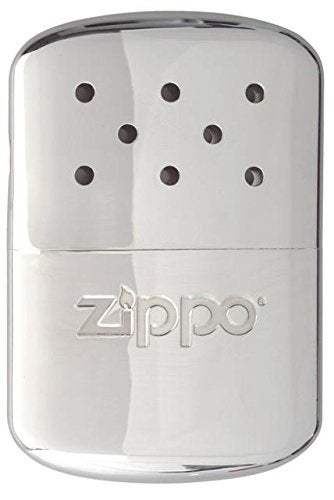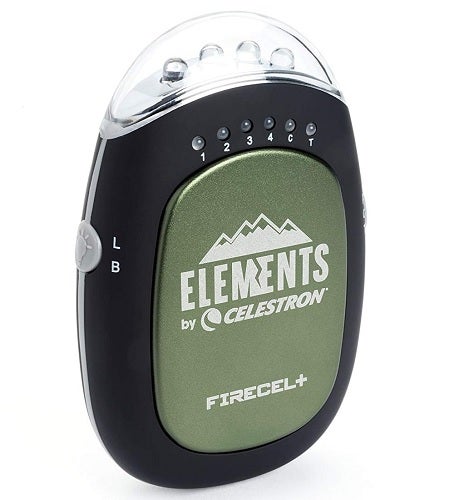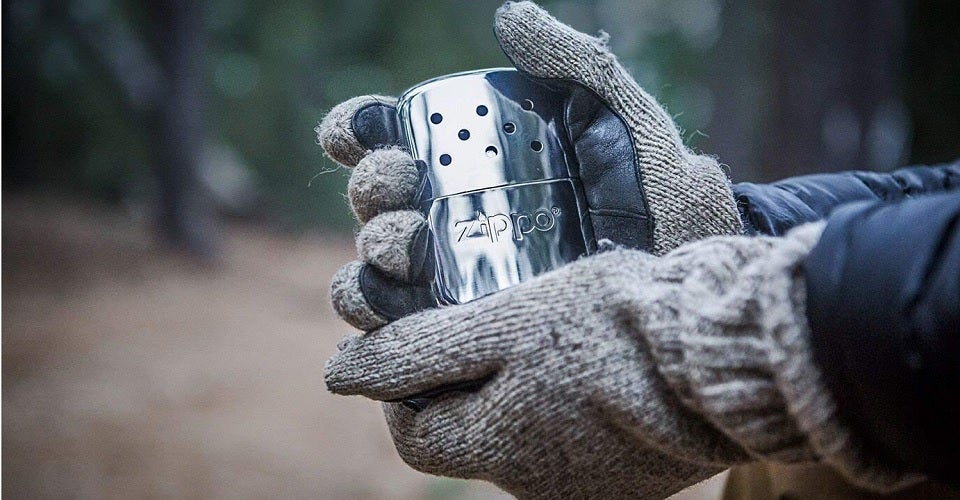
Our Editors independently research, test, and rate what we feel are the best products. We use affiliate links and may receive a small commission on purchases.
As a full time ski instructor in the Wasatch Mountains, I know what it’s like to spend time in some seriously rugged conditions. Take it from me, hand warmers are not a cheap way out – they’re often the difference between having a great day, and a terrible one.
When the choice is between grabbing a hand warmer or potentially having to head inside and miss the killer storm blowing in, most people opt for the hand warmer. Unfortunately, it’s expensive to pick up hand warmers last second. That’s why we’re going to help you figure out which hand warmers are right for you!
Best Hand Warmers
Have a look through these related Outside Pursuits guide links: Base Layers, Heated Jackets, Heated Socks.
Quick Answer: The Best Hand Warmers
- Zippo Rechargeable Hand Warmer
- BigBlue Rechargeable Electronic Hand Warmer
- Zippo Hand Warmer
- HotHands Hand Warmers
- Celsius Solid Fuel Hand Warmer
- The Outdoors Way Rechargeable Hand Warmer
- Celestron Elements Plus Hand Warmer
Without further ado, let’s break it down with the top hand warmers currently on the market, then we’ll talk about how to choose the best one for you in our buying guide.
Hand Warmer Reviews
#1 Zippo Rechargeable Hand Warmer
- Type: Rechargeable Electric
- Heat: 107F (~6.5 hrs), 118F (~5 hrs)
- Battery Size: 5200mAh
- Flashlight: Yes
- Dual Mode: No, heats both sides only
What can’t be done with technology? It’s a fair question as we look at this handwarmer that’s got just about everything going for it.
Six heat settings give you control over this electronic hand warmer’s output for optimizing heat and battery life.
If you’ve got a phone or other gadget that’s dying, you can even give it a charge from the batteries in this hand warmer.
It’s like a portable battery pack with the option to heat up your chilly hands. The Zippo Rechargeable Hand Warmer is one of best hand warmers for skiing!
You’ll be able to warm up your hands on both sides of the electronic hand-warmer for up to 6.5 hours on the lowest setting!
Unfortunately, it’s too large and heavy to stuff inside a glove so you’ll have to find a place for it in a pocket or jacket.
In my opinion, this is the best rechargeable hand warmer you can buy.
#2 BigBlue Rechargeable Hand Warmer
- Type: Rechargeable Electric
- Heat: 113F (~4.0 hrs), 130F (~2.5 hrs)
- Battery Size: 6000mAh
- Flashlight: Yes
- Dual Mode: No, heats both sides only
What’s the biggest difference between any two electronic hand warmers? It’s definitely the form factor and the battery life.
With a 6000mAh battery you’ll be able to get 2.5 charges of an iPhone 7 or up to 4 hours of warmth at 113 degrees output. That’s a lot of heat on both sides of this rechargeable electronic handwarmer.
I like this hand warmer for its slimmer profile which will fit more easily into commuter cases and purses.
This is definitely a good choice for a more sleek and modern elegance.
Cold temperatures can really destroy the effective battery life of electronics. Luckily there’s an easy on-off switch and you’ll be able to extend the life of your battery pretty dramatically by keeping it in an inside pocket.
If you looking for the best electric hand warmer, the BigBlue rechargeable is for you!
#3 Zippo Hand Warmer
- Type: Catalytic (Lighter Fluid)
- Heat: 110F (12 Hours)
- Battery Size: N/A
- Flashlight: No
- Dual Mode: No, heats both sides only
I would be remiss to avoid listing the classic Zippo hand warmer as the number one choice among peers. Cold blooded individuals have more choices than ever today, yet there’s something timeless about the Zippo.
It’s easy to pick up this hand warmer in both a 12-hour and 6-hour format and they’ll both be different sizes.
Choose whichever one makes the most sense for your needs based on size and burn time.
Without a doubt one of the biggest drawbacks of the Zippo hand warmers is that they’re constant burning once you start them.
There’s no on-off switch and if you head inside, you’ll have a toasty 110 degree hand warmer burning away inside your pocket.
The Zippo catalytic hand warmer has been around forever, and still the best!
#4 HotHands Disposable Hand Warmers
- Type: Catalytic (Disposable)
- Heat: 102F (10 Hours)
- Battery Size: N/A
- Flashlight: No
- Dual Mode: No, heats both sides only
These are “hands down” the most popular hand warming solution for the modern cold weather pursuer.
If you buy them in bulk, they’re really not too expensive but beware – they’ll add up over time compared to other options.
It doesn’t get any easier to use than these disposable chemical hand warmers. Just rip open the plastic packet, put the hand warmers in your glove or pocket, and they’ll be comfortably warm within a few minutes.
It does take them a while to get warm, however, so add them to your gloves before your hands get cold.
Unfortunately, they do have a tendency to occasionally break open. If this happens inside of your gloves, you can pretty much kiss them goodbye.
Once open, the packets spill their dark black iron powder and carbon contents everywhere and your hands will be eternally black every time you use your gloves. Something to consider.
However, the HotHands, are probably the best disposable hand warmers you can buy.
#5 Celsius Solid Fuel Hand Warmer
- Type: Catalytic
- Heat: 105F (6 Hours)
- Battery Size: N/A
- Flashlight: No
- Dual Mode: No, heats both sides only
You’ve probably never seen a handwarmer quite like this one. Here’s the basic idea: light the solid fuel stick with a match or lighter, then simply place it inside the fiberglass insulated case and close the lid.
By restricting access to oxygen, the solid fuel stick “smolders” and slowly burns at a very controlled rate which releases heat through the insulated case.
Don’t worry though, because the solid fuel tabs are specially engineered to not release any smoke or odor when burning. There’s no danger of fire because the fiberglass insulation inside the case won’t combust.
While this type of handwarmer was once more popular than it is today, the inexpensive fuel sticks and simplicity make it a great option.
For those not fazed by the thought of combustible solid fuel generating heat, these handwarmers are among the warmest you can choose.
They’re great for deep cold and situations where recharging is out of the question.
#6 The Outdoors Way Rechargeable Hand Warmer
- Type: Rechargeable Electric
- Heat: 105F (~7 hrs), 115F (~4.5 hrs)
- Battery Size: 7800 mAh
- Flashlight: Yes
- Dual Mode: No, heats both sides only
With a 7800 mAh Lithium-Ion battery, the Outdoors Way electric hand warmer is the most powerful on our list. It’s ruggedly built from aircraft grade aluminum and double sided heat up to 115 degrees.
It’s also able to charge your smartphone or other portable electronics and on the lower setting heat setting of 105 degrees will give you 7 hours of warmth.
I like they included a 55 lumens flashlight and SOS signal light. It’s not super bright but it’s enough so you don’t need a separate flashlight.
If you’re looking the best hand warmer for hunting, the Outdoors Way is for you!
For the ladies, there is a pink model and Outdoors Way makes a donation to Breast Cancer Awareness.
#7 Celestron Elements – Hand Warmer/Charger/Flashlight
- Type: Rechargeable Electric
- Heat: 107F 12 hours / 2 sides, 6 hours
- Battery Size: 6000 mAh
- Flashlight: Yes
- Dual Mode: Yes, heat one side or both
Rounding out our list it the Celestron Elements rechargeable hand warmer. It’s a bit smaller and more compact but still has a 6000 mAh lithium ion battery that provides up to 12 hours of warmth.
One thing I like about the Elements is the dual mode capability. You can choose to heat only one side or both depending on how you use it and how long you want the battery to last.
Like the other rechargeable hand warmers, it will charge your smartphone or other portable electronics. The Elements is designed more for hikers and backpackers with its variety of signaling features.
It has 5 modes and a red and white flashlight and SOS mode. For under $50 it’s one of the best reusable hand warmers on the market!
Hand Warmer Comparison table
| Hand Warmer | Heating Type | Temperature | Hours of Heat | Battery Size | Rating | |
|---|---|---|---|---|---|---|
| Zippo Rechargeable Hand Warmer | Electric | 107F - 118F | 5.0 - 9 | 5200mAh | 4.2 / 5.0 | |
| BigBlue Rechargeable | Electric | 113F - 130F | 2.5 - 4.0 | 6000mAh | 3.9 / 5.0 | |
| Zippo Hand Warmer | Catalytic | 110F | 12 | N/A | 4.0 / 5.0 | |
| HotHands Disposable | Chemical | 102F | 10 | N/A | 4.5 / 5.0 | |
| Celsius Solid Fuel | Catalytic | 105F | 6.0 | N/A | 5.0 / 5.0 | |
| The Outdoors Way Rechargeabler | Electric | 105F - 115F | 4.5 - 7.0 | 7800 mAh | 4.5 / 5.0 | |
| Celestron Elements Plus | Electric | 107F | 6.0 - 12 | 5300 mAh | 4.2 / 5.0 |
Author’s Expertise / Why You Should Trust Our Reviews

I started writing online for my own outdoor sports blog in 2010. Right out of the gate I landed opportunities to test gear for Road ID, Hydrapak, Wolverine, Helle Knives, Pearl Izumi, and GU Energy. Those were the days when growing a no-name blog was easy. Today niche blogging is a different story.
In 2012 I left Central Wyoming College with a degree in Outdoor Education and Leadership. Soon after, I was on a month-long expedition with the National Outdoor Leadership School’s Outdoor Educator Course which helps would-be outdoor guides ascend from “aspiring” to “inspiring”.
Between here and there I’ve participated in and spoken at length about outdoor pro-deal programs for companies like Patagonia, Smith Optics, Giro, Therm-a-Rest, Platypus, MSR, Columbia, and many more. I still work closely with tons of outdoor gear companies to review and analyze products. If you have a product opportunity you’d like to discuss, please review my guidelines and contact me here.
After several seasons of guiding backpacking trips and working as a certified Alpine Ski Instructor at Deer Valley Resort in Park City, UT for several seasons, I had to move on. As any educator will tell you – teaching doesn’t pay the bills very well.
In 2016 I began building my freelance writing career as readers and other bloggers reached out to me for help with technical outdoor sports content strategy for online businesses. Within weeks I was overloaded with requests for freelance writing and my new career blossomed.
2018 saw the launch of Hike With Less, my ultralight backpacking partnership program with Dustin Walker.
How to Choose the Best Hand Warmer – Buyers Guide
- Electric vs Catalytic vs Chemical
- Length of Heat
- Reusable vs Single Use Warmers
- Temperature Rating
- Hand Warmer Uses
- Assessing Your Needs
- Final Thoughts
 Some handwarmers are dead simple and disposable – you’d think there’s not much that goes into making a decision about the purchase.
Some handwarmers are dead simple and disposable – you’d think there’s not much that goes into making a decision about the purchase.
Fortunately for you, I know better and I’m going to help you avoid a few critical mistakes with your choice.
Electric vs Catalytic vs Chemical
When choosing a hand-warmer twenty years ago, there was only one option: catalytic hand warmers. It’s a pretty simple concept: use a fuel source and a type of harmless energy release to generate heat in a manner that can be carried.
Today, we’ve got a lot more options when it comes to hand warmers. With the improvement of electric batteries and nano-tech there are electric handwarmers galore.
Many people aren’t fully comfortable carrying around a handwarmer fueled by lighter fluid and so these newer tech hand warmers have had a “warm” welcome into the market.
There’s also the disposable and effective chemical hand warmers. These are cheap, one time use packets which heat up when exposed to the air and will last for ~8 hours per use. They’re popular and get the job done.
Electric Hand Warmers
Today’s electric hand warmers come with a heap of advantages that make it hard to consider conventional hand warmers a viable option any more.
Plug your hand warmer into a socket overnight to charge the device and have a reliable heat source that will last all day without a problem.
What advantages to electric handwarmers have? You can turn the handwarmer on and off to save battery life. Often you can even plug a phone into the handwarmer and recharge your phone using some extra juice from the battery!
Of course, this will shorten the duration of the hand-warmer but I think it’s a fair trade.
Pros:
- Rechargeable
- No need for lighter fluid smell or purchase
- Can charge other electronic devices
Cons:
- Shorter duration than catalytic warmers
- Won’t work if you forget to charge it
Catalytic Hand Warmers
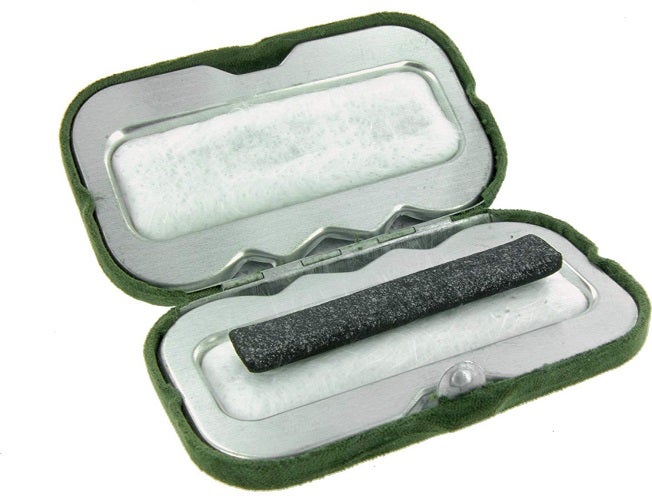
This is just another way of saying “hand warmer that burns fuel”. Without a doubt, the most striking example is the Zippo handwarmer which has been around for decades and still stands the test of time.
Catalytic handwarmers use a fuel source such as lighter fluid to combust in an extremely slow and controlled reaction to release heat.
While it’s a little disconcerting to have something burning in your pocket, these handwarmers have been used and loved for years.
Pros:
- Long life span (15+ hours)
- Can be refilled with lighter fluid available in any gas station
- Elegant and classic appeal
Cons:
- Lighter fluid has a negative smell to many
- Idea of something combusting in your pocket may be off putting
Chemical Hand Warmers
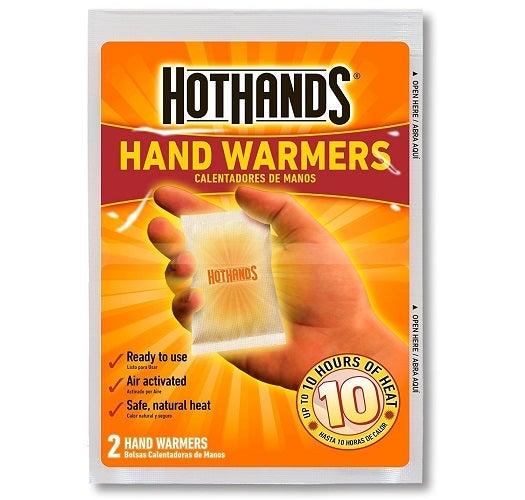 Most chemical handwarmers operate by taking advantage of the exothermic reaction of rusting iron. By mixing iron powder, water, and carbon inside a fiber pouch these little handwarmers will start a chemical reaction once exposed to the air.
Most chemical handwarmers operate by taking advantage of the exothermic reaction of rusting iron. By mixing iron powder, water, and carbon inside a fiber pouch these little handwarmers will start a chemical reaction once exposed to the air.
Essentially your hands are being warmed up by a hyper-speed version of the same process which will eventually destroy the undercarriage of your car.
Chemical hand warmers are without a doubt the most popular solution I see at the ski resort today.
They do come with a few drawbacks, however:
Pros:
- Simple and widely available
- Small form factor
- Inexpensive one-time solution
Cons:
- Packets can rip open and leave black residue inside your gloves (ruined)
- Price will add up over time compared to other options
Length of Heat
Naturally your buying a hand warmer to keep your hands warm so the length of time it stays warm is one most important factors. There are very wide variations depending on the heat source used. So consider how long you will be outside needing the heat and match the type of warmer. Here are the approximate hours you can expect.
Battery Warmers: 2.5 – 7 hours
Chemical: 6-12 hours
Reusable vs Single Use Warmers
One of the biggest differences is going to be cost. A reusable hand warmer will cost more up front but since you can either recharge it or refill it with inexpensive fuel the cost of ownership is much lower over time.
Single use warmers have the advantage of size and drop dead simplicity. They are ideal for activities like skiing, snowboarding, camping & hiking, climbing etc. Most disposable warmers will fit in your gloves or boots unlike reusable warmers. So you may want to consider using both types.
Temperature Rating
Going hand in hand with hand with length of heat is how hot the warmer gets. This is partially a function of the heat source. Battery warmers don’t usually get as hot as a warmer using fuel or a chemical reaction.
On the low end you should expect just over 100 degrees F and up to 130F. Much over that and you can burn your hands and under 100F it won’t provide much warm. Rechargeable heaters usually are more flexible giving you at least two heat settings while catalytic and disposable have one temperature only.
Hand Warmer Uses
Hand warmers can be used for a wide variety of outdoor activities. Probably the most popular use for them is skiing and snowboarding. Skiers and boarders mostly use the disposable variety and slip them into their gloves and boots for all day warmth. People who suffer from cold feet and hands they can make all the difference on the slopes.
Another very popular use of warmers is for hunting and fishing, particulary ice fishing. Both of these activities involve spending long periods of time in one place not moving. Not being able to move makes it that much more difficult to keep warm so hand and feet warmers can make a huge difference in comfort level. Using a heated jacket can also make a huge difference.
One other less common use is for golfers, or concert goers where they’re outdoors in cooler weather. Workers who spend long periods of time outdoors as well can also find wand warmers useful.
Assessing Your Needs
Which type of handwarmer you choose will be largely dependent on your lifestyle. If you’re in the cold every day, all day, then you may choose a rechargeable handwarmer.
If you’re taking a one-time ski trip, you might choose a simple set of disposable chemical hand warmers. Let’s look at a few situations:
Commuting to Work
In this situation, you probably want some way to warm up your hands on the bus or in the car before things get warm. Maybe you’re walking down the windy streets of Chicago on a bitterly cold day.
Rechargeable hand warmers are the best solution here as you’ll have access to electricity and the long-term cost of disposable hand warmers will quickly add up.
Skiing Every Weekend
You’ll want to consider two options:
If your hands are always cold, then you’ll want chemical hand warmer packets to put inside your gloves. They’re the only solution that’s small enough and flexible enough to fit inside a glove.
This will quickly get expensive at about $1 per hand warmer, but the only other solution is a heated glove.
If your hands are only sometimes cold, you may opt for a rechargeable hand warmer which can be kept turned off until things get really cold. Then you can tuck your hands into your jacket and warm back up while you sip on a hot cocoa.
FAQs About Hand Warmers
Q: Where do I put my hand warmers?
A: The best place to put a hand warmer is in a dedicated pocket on your gloves. Some gloves in the last few years have been coming out with zippered pockets on the back of the hand where you can put hand warmers. Of course, these are only safe for electric or disposable hand warmers.
For catalytic or fuel based hand warmers, they’re usually just too large to fit. For that reason you’ll have to keep them in a pocket.
For active tasks, like skiing or snowshoeing you’ll probably want those hand warmers right in your gloves. If your gloves don’t have a hand warmer pocket you may put them inside the glove itself. Be careful, though, because these hand warmers can actually get hot enough to be dangerous directly next to skin.
Q: Are chemical hand warmers bad for the environment?
A: I can’t really say definitively, but if I had to make a guess I’d say they’re relatively neutral on the scale of “bad to the environment”.
Most chemical hand warmers are made from powdered iron which releases heat as it oxidizes in exposure to atmospheric gasses. Of course, iron is a natural part of the outdoor resources around us but I’m not saying we need to be careless with it. I’m just saying it’s relatively harmless compared to many chemicals we use daily.
Probably the worst part about chemical hand warmers are the fiber packets they come in as it pertains to negatively affecting the environment. They fall out of gloves all the time and, on busy ski hills, when the snow melts in the spring these little white rectangles litter the landscape.
Essentially, use them responsibly, try not to litter, and dispose of them properly at the end of the day. Just like anything else.
Q: Can I use hand warmers in my boots?
A: Again, simply because of the size, the only warmers that will fit in boots are chemical packets. In fact, some companies make sticky half-size warmers specifically for going on your sock and keeping those toes warm all day!
If you’re skiing, snowboarding, or snowshoeing you might want to look into these toe warmers.
Another great solution is to use electric boot warmers. You can find them made for regular boots, snowboard boots, or skiing boots. Usually they replace the standard footbed with one that has a heating element.
Dedicated boot warmers have the added benefit of not affective the ergonomics of the boot itself!
Q: How long will my hand warmers last in storage?
A: That’s a great question. Most disposable hand warmers have an expiration date on them.
If you’re thinking ahead then you know you should probably avoid stocking up on too many of them. Unused chemical hand warmers will likely go bad after several months so use them up within a season or two.
Once you open a hand warmer packet, there’s no real way to stop it from activating. It will “burn out” after a few hours and you’ll just have to use another one.
Q: When is the best time to use a catalytic or fuel hand warmer?
A: Because both of these types of hand warmers are too large to fit in a glove, it begs the question of when to use them. If you have to take your hands out of your gloves and stick them in a pocket with a hand warmer, how effective can it be?
In situations where you may be a little more passive – such as ice fishing, working in the garage, or tailgating – these larger hand warmers might be a decent idea. You can cup them in your hands, gloved or not, to warm up!
What it boils down to is that the more passive your activity is, the better a catalytic or fuel-based hand warmer will be for that activity.
Outside Pursuits Overview
It’s not too difficult to find great options for any cold hand situation. For those with gloves participating in active sports, the best choice might be chemical handwarmers. The small, flexible packets are great for including inside your gloves.
Many of us will like the appeal of a handwarmer with on-off functionality and the backup to charge our phone. It’s always handy to have a spare battery around and the added benefit of warming your hands on the family ski trip can’t ever hurt!
Whatever type of hand warmer you decide to go with, the classic Zippo is a high content for sleek style and ultra-long run time. Make sure you bring along an extra bottle of lighter fluid, though, or you’ll be out of luck!
I hope this guide was helpful for finding the best hand warmer to fit your needs. If you want to comment or recommend a jacket I didn’t include, please use my contact form to get in touch.
How We Researched
To come up with the best hand warmers, we researched a variety of sources for reviews such as REI, Backcountry, Moosejaw, EVO along with our own personal experience.
We also consulted online magazines for product research and reviews to get as much unbiased information as we could. To help weed out fake reviews we used Fakespot.com to make sure we only looked at genuine reviews.
With so much quality gear available, we had to narrow it down based on what we felt were the best options were for the price. The author, Casey Fiedler was a full-time ski instructor for Park City and The Canyons in Utah.
To help narrow down the selection he used his personal experience along with recommendations from fellow ski instructors.
After extensive research, we came up with our list to help you choose the right one for you.
Sources

